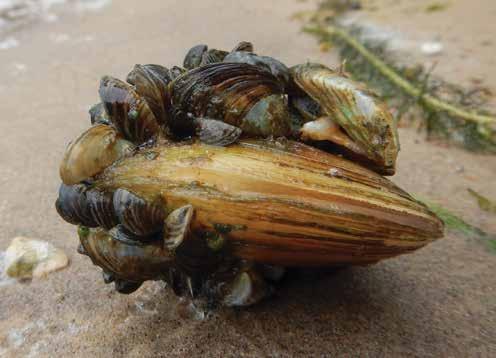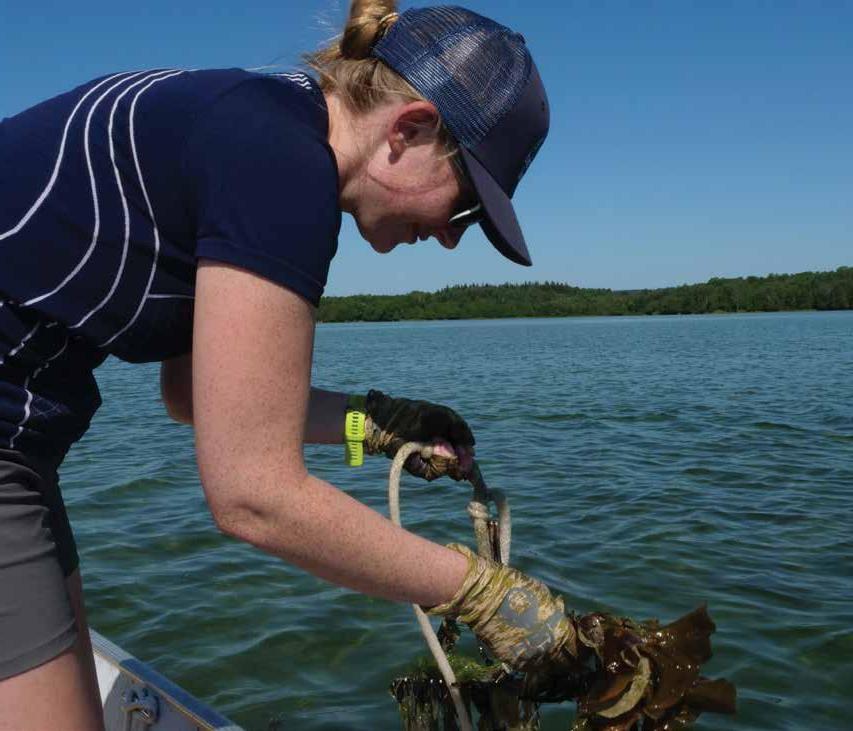
4 minute read
Aquatic Invasive Species are a Problem in Michigan
ZEBRA MUSSELS: Zebra mussels can filter out and eat large quantities of microscopic aquatic organisms and disrupt food chains in Michigan lakes. They can also attach to boat hulls, docks, water intake pipes, and other animals. As you can see in this picture, zebra mussels have covered a clam in Douglas Lake. Their habit of attaching to any available surface can make it difficult for other aquatic life to feed and move.
The good news? You’re part of the solution!

By Jennifer DeMoss, Tip of the Mitt Watershed Council Communications Director
You may have noticed that Tip of the Mitt Watershed Council has an ad with the words, “Clean. Drain. Dry” in this issue of Docklines. That ad is about our commitment to preventing the spread of aquatic invasive species throughout Northern Michigan waterways. But what are aquatic invasive species? How can they damage Michigan’s economy, boating, and fishing? And what can we do about them? It turns out that there’s a lot that the Watershed Council, boaters, and other recreationists can do to prevent the spread of aquatic invasive species and help keep the waters we love healthy. So take the plunge with us and see how you can help protect the lakes you love.
AQUATIC INVASIVE SPECIES
While boating or fishing, you may have spotted delicate ribbon-like leaves of eel grass, or heart-shaped pondweeds. Some plants you see floating beneath and on the water’s surface are native to Michigan. These species have been here for thousands of years and animals might depend upon them for habitat or as a food source.
However, not all aquatic plants are healthy for the places they grow. An invasive plant species is one that is introduced from another area and ends up causing environmental and/or economic harm.
Take, for example, Eurasian watermilfoil. It looks a lot like a native plant called northern watermilfoil, but it doesn’t act like it. As its name suggests, this watermilfoil is from Europe and Asia. As reported in the Science Around Michigan blog, Michigan Tech ecologist Kevyn Juneau regards this species as one of the most invasive aquatic species in Michigan. It can grow rapidly into dense mats that even animals can walk across and block out light for other aquatic species. It can also get tangled in fishing gear and boat motors, making it harder for people to enjoy water recreation. Hundreds of millions of dollars are spent in the U.S. every year combatting this single invasive plant, which is well established in Burt, Long, Walloon, and Paradise Lakes.
Plants aren’t the only problem. You’re probably familiar with zebra mussels, a Eurasian invasive bivalve that can remove almost every microscopic plant and animal from a body of water, disrupting entire food chains. Or rusty crayfish, which aggressively hunt fish and eat their eggs, while displacing native crayfish. These invasive species can take a toll on fisheries and reduce anglers’ and boaters’ enjoyment of our beautiful Michigan waterways.
WHAT ABOUT CLEAN, DRAIN, DRY?
The fact that aquatic invasive species are widespread throughout Michigan can be depressing. However, the good news is that we don’t have to let them colonize every body of water that we love. There are still lakes in Michigan that don’t have invasive species. The Watershed Council is dedicated to making sure that native aquatic species have a chance to thrive, and you’re already part of that effort.
Think about it this way: some of the invasives we encounter got here in ballast water, or because people released live bait into water bodies. Stopping the activities that got invasive species here in the first place can help prevent their spread.
And if you want to learn more about invasives and keep an eye out for them on your favorite lake, search for this web address (warning, the sea lamprey pictures might give you nightmares): https://www. watershedcouncil.org/aquatic-invasivespecies.html.
Thanks for being part of the solution to the invasive species problem in Northern Michigan. The Watershed Council couldn’t do it without you.

Below are some helpful tips you can use to maintain healthy waters for boating and fishing.
• Clean: When your boat leaves the water, it can harbor invasive species, even ones you can’t see. Remove visible mud, plants, fish, or animals from your boat, trailer, or other equipment (anchor, centerboards, props, etc.) before leaving the water body. You can also wash your boat off at home with hot water and a phosphate-free, biodegradable, non-toxic detergent, or a homemade detergent from items like vinegar and baking soda. Just make sure the wash water drains into the ground, and not into a stream or lake, and that you’re washing your boat before you enter a different lake.
• Drain all water from live wells, bilges, motor, transom, and other containers before leaving launch area. • Dry: Allow your boat to dry for a minimum of 5 days in a sunny location before transferring into a new body of water.
• Do not release live bait or aquarium pets into any waters. • Visit one of our mobile boat washing stations if you’re in the area. There are weekly posts about our boat washing stations on our Facebook page: https://www.facebook.com/ watershedcouncil. Watershed Council staff can wash your boat for free and offer lots of information and swag.
We have even more tips on boat maintenance for healthy waters at this webpage: https://www.watershedcouncil.org/ clean-boating.html
EURASIAN WATERMILFOIL: Eurasian watermilfoil is considered one of the most invasive plants in the U.S. Hundreds of millions of dollars go into controlling its spread each year. It roots into the muck in the bottom of a lake and can spread through root runners or even plant fragments. Washing watermilfoil fragments off of boats is a key part of preventing its spread.










